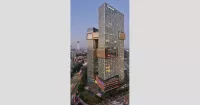Shenzhen is a major city in Guangdong province, China, designated as a special economic zone. Situated on the Pearl River estuary, it borders Hong Kong and is one of China's most populous cities with over 17.5 million residents. Shenzhen is renowned for its economic significance, housing the world's fourth busiest container port, reflecting its crucial role in global trade.
1911: Xin'an Residents Rebel Against Qing Administration
In 1911, in response to the Wuchang Uprising, residents of Xin'an rebelled against and overthrew the local Qing administration. The Chinese section of the Kowloon–Canton Railway (KCR) also opened to the public in 1911, with the last stop on the Chinese side being Shenzhen railway station.
1913: Xin'an County Renamed Bao'an County
In 1913, the Republic of China administration renamed Xin'an County back to Bao'an County to prevent confusion with another county of the same name in Henan Province.
1931: Chen Jitang Establishes Casinos in Shenzhen
In 1931, Chen Jitang and his family established several casinos in Shenzhen, with the Shumchun Casino being the largest.
1941: Japanese Army Attempts to Enter Hong Kong
During World War II, in 1941, the Japanese army attempted to cross into Hong Kong through the Lo Wu Bridge in Shenzhen, but the bridge was detonated by the British, preventing their entry.
1953: Bao'an County Government Moves to Shenzhen
In 1953, the Bao'an County government relocated to Shenzhen due to its proximity to the Kowloon–Canton Railway (KCR) and its larger economy compared to Nantou.
February 1957: Extreme Low Temperature
On 11 February 1957, Shenzhen recorded an extreme low temperature of 0.2 °C (32 °F).
January 1978: Central Inspection Team Investigates Bao'an County
In January 1978, a Central Inspection Team investigated Bao'an County to assess the possibility of creating a foreign trade port.
August 1978: Proposal to Change Bao'an County to Shenzhen
In August 1978, the Huiyang District Committee reported on the "Report on the Request for the Change of Bao'an County to Shenzhen", pushing for the county to be renamed Shenzhen.
January 1979: Proposal to Rename Bao'an County to Shenzhen
On 23 January 1979, the Guangdong provincial administration and the district of Huiyang announced their proposal to rename Bao'an County to Shenzhen and was approved and put into effect by the State Council on March 5 of that year.
March 1979: Shenzhen City Established
On 5 March 1979, the State Council of the People's Republic of China dissolved Bao'an County and established Shenzhen City in its place, initially with six districts.
Apr 1979: Shenzhen Reformed as Special Export Zone
Back to Apr 1979, Shenzhen was reformed as a Special Export Zone to create a favorable investment environment and introduce advanced technology and management experience.
April 1979: Proposal to Set Up a Trade Cooperation Zone in Shenzhen
At the beginning of April 1979, the Standing Committee of Guangdong Province discussed and proposed to the Central Committee to set up a "trade cooperation zone" in Shenzhen, Zhuhai, and Shantou. In the same month, the Central Working Conference decided on the "Regulations on Vigorously Developing Foreign Trade to Increase Foreign Exchange Income" and agreed to pilot the first special economic zones (SEZ) in Shenzhen, Zhuhai, Shantou, and Xiamen.
1979: Shenzhen Becomes a City
By 1979, Shenzhen's economy grew and it became a city. Shenzhen railway station was the last stop on the mainland Chinese section of the Kowloon–Canton Railway.
May 1980: Renamed to Special Economic Zone
In May 1980, Shenzhen was renamed to Special Economic Zone.
May 1980: Shenzhen Designated as the First SEZ in China
In May 1980, the Central Committee designated Shenzhen as the first Special Economic Zone (SEZ) in China, as part of China's reform and opening-up policies.
July 1980: Extreme High Temperature
On 10 July 1980, Shenzhen recorded an extreme high temperature of 38.7 °C (102 °F).
1980: Establishment of Shenzhen as SEZ
From the establishment of Shenzhen as a SEZ in 1980 to 2007, Hong Kong has been Shenzhen's largest trade partner.
March 1981: Shenzhen Promoted to a Sub-Provincial Division
In March 1981, Shenzhen was promoted to a sub-provincial division, marking its growing importance and autonomy.
October 1981: Bao'an County Re-established
In October 1981, Bao'an County was re-established, with its region now based outside Shenzhen.
1981: Legislative Powers Granted to Shenzhen
In 1981, the National People's Congress (NPC) granted legislative powers to Shenzhen and other Special Economic Zones, allowing the city to make its own laws and regulations.
June 1983: Districts Re-established as Management Areas
In June 1983, the districts were dissolved and re-established instead as five management areas.
1983: Opening of Shenzhen Normal School and Shenzhen University
In 1983, Shenzhen Normal School opened to train primary school teachers, and Shenzhen University became Shenzhen's first comprehensive full-time higher educational institution.
1983: Erection of the Second Line Border in Shenzhen
In 1983, to enforce law and order, the Shenzhen government erected barbed wire and checkpoints, known as the second line border, between the SEZ and the rest of China.
October 1989: Houston and Shenzhen Sister Cities
In October 1989, Houston became the first sister city of Shenzhen.
January 1990: Management Areas Merged to Form Districts
In January 1990, the city merged Shekou Management Area and Nantou Management Area to form the Nanshan District, renamed Shangbu Management Area to the Futian District, and merged Luohu Management Area and Shatoujiao Management Area to form the Luohu District.
October 1990: First McDonald's in Mainland China Opens in Shenzhen
On October 8, 1990, the first McDonald's restaurant in mainland China opened in Shenzhen's Luohu District, bringing American fast food to the city.
1991: Captured Border-Crossers Statistics
In 1991, there were 16,000 captured border-crossers into Shenzhen.
February 1992: Shenzhen Granted Power to Make Local Laws
In February 1992, the Standing Committee of the National People's Congress (NPC) granted the government of Shenzhen the power to make local laws and regulations.
December 1992: Bao'an County Dissolved and New Districts Established
In December 1992, Bao'an County was dissolved again, with its area taken by Shenzhen and split into two new districts: Bao'an District and Longgang District.
1996: Shenzhen High-tech Industrial Development Zone Established
In 1996, the State Council approved and established the 11.5 km (4.4 sq mi) Shenzhen High-tech Industrial Development Zone, helping to develop Shenzhen's high-tech industry in areas such as electronics and information technology.
March 1998: Yantian District Created
In March 1998, Shenzhen's government created the Yantian District from the eastern portions of the Luohu District.
1999: Establishment of Shenzhen Virtual University Park
In 1999, the Shenzhen Municipal Government set up the Shenzhen Virtual University Park in the Science and Technology Park, where teachers from China's top universities taught graduate students.
2000: Shenzhen River Restoration Project Began
In 2000, Shenzhen began a project to restore the city's rivers from water pollution.
2000: Captured Border-Crossers Statistics
In 2000, as a result of Shenzhen's increasing economic prospects, increasing numbers of migrants from mainland China chose to go to Shenzhen and stay there instead of trying to illegally cross into Hong Kong. There were 9,000 captured border-crossers in 2000.
2000: Mangrove Ecopark Established
In 2000, the Mangrove Ecopark was established in the Futian District, becoming the smallest national park in China at that time.
May 2001: Shenzhen Hosts Second Senior Officials' Meeting of APEC China 2001
Around May 2001, Shenzhen hosted the second Senior Officials' Meeting of APEC China 2001 in its southern manufacturing center and port.
2001: Shenzhen Software Park Established
In accordance to the National Plan in 2001, the Shenzhen Software Park, integrated within the High-tech Industrial Development Zone, was established for software production and assists in the development of the city's software industry.
December 2002: Zhao Yucun sentenced for bribery
In December 2002, the Shenzhen People's Intermediate Court sentenced Zhao Yucun, former Commissioner of Shenzhen Customs, to life imprisonment for taking bribes of 9 million RMB.
November 2003: Wang Ju sentenced for bribery and abuse of power
In November 2003, the Guangzhou People's Intermediate Court charged former Shenzhen Deputy Mayor Wang Ju with bribery and abuse of power and sentenced him to 20 years in prison.
2003: Establishment of "Library City" concept
In 2003, Shenzhen's municipal government established the "Library City" concept to create a library network through construction, service improvement, and a comfortable reading environment.
2003: Plans to Develop Shenzhen as a Cultural City
In 2003, the municipal government announced plans to turn Shenzhen into a cultural city by promoting design, animation, and library construction.
November 2004: First Shenzhen International Cultural Fair
In November 2004, Shenzhen hosted the first Shenzhen International Cultural Fair, an expo specializing in the world's cultural industries.
June 2005: An Huijun sentenced for accepting bribes
In June 2005, the Shenzhen People's Intermediate Court charged and sentenced Luohu District Public Security Director An Huijun to 15 years in prison for accepting bribes.
2005: Ranked as World's Fourth-Busiest Container Port
With rising trade increased cargo shipments in 2005, the Port of Shenzhen was ranked as the world's fourth-busiest container port.
2006: Establishment of Public Park System
In 2006, Shenzhen established an extensive three-level public park system, categorizing parks as natural, urban, and community parks.
August 2007: Guangming New District Established
In August 2007, the Shenzhen government established Guangming New District as part of the guanwai.
2007: Hong Kong Largest Trade Partner Until 2007
From the establishment of Shenzhen as a SEZ in 1980 to 2007, Hong Kong has been Shenzhen's largest trade partner.
May 2008: State Council Approves Promotion of Shenzhen SEZ
In May 2008, the State Council approved the Shenzhen SEZ to promote Shenzhen's administrative management system, economic system, social field, independent innovation system and mechanism, system and mechanism for opening up and regional cooperation, and resource conservation and environmental friendliness.
December 2008: Shenzhen Designated United Nations Design Capital
On 7 December 2008, UNESCO approved Shenzhen's entrance into the Creative Cities Network, and awarded the Shenzhen the title of "United Nations Design Capital."
June 2009: Pingshan New District Established
In June 2009, the Shenzhen government established Pingshan New District as part of the guanwai.
2009: Establishment of Holy Confucian Church
In 2009, Shenzhen hosted the headquarters of the Holy Confucian Church.
2009: Shenzhen Pilots New-Energy Vehicle Program
In 2009, Shenzhen was chosen as one of thirteen cities to pilot a national new-energy vehicle program.
July 2010: Second Line Border Dissolved and SEZ Expanded
On 1 July 2010, the second line border was dissolved, and the Shenzhen SEZ was expanded to cover the entire city.
July 2010: Dissolution of the "Second Line" and Expansion of Shenzhen SEZ
On July 1, 2010, the State Council dissolved the "second line" and expanded the Shenzhen SEZ to include all districts, increasing its size fivefold.
August 2010: Overall Development Plan for Qianhai Shenzhen-Hong Kong Modern Service Industry Cooperation Zone Approved
On 26 August 2010, the State Council approved the "Overall Development Plan for Qianhai Shenzhen-Hong Kong Modern Service Industry Cooperation Zone" to solidify ties between Hong Kong and Shenzhen.
August 2010: Approval of Development Plan for Qianhai Shenzhen-Hong Kong Cooperation Zone
On August 26, 2010, coinciding with the 30th anniversary of the establishment of the Shenzhen SEZ, the State Council approved the "Overall Development Plan for Qianhai Shenzhen-Hong Kong Modern Service Industry Cooperation Zone."
2010: Religious Demographics Survey
According to a 2010 survey by the University of Southern California, approximately 37 percent of Shenzhen's residents were practitioners of Chinese folk religions, 26 percent were Buddhist, 18 percent Taoist, 2 percent Christian, and 2 percent Muslim.
2010: City's Permanent Population Increase
From 2010 to 2020, the city's permanent population increased by 7,136,088, for an average annual growth rate of 5.35%.
2010: Tourism Industry Increase
In 2015 the tourism industry's total revenue was 124.48 billion RMB (US$17.6 billion), a 98.1 percent increase from 2010. In that year, Shenzhen received 11.63 million tourists, a 51 percent increase from 2010.
May 2011: Xu Zongheng sentenced to death penalty
In May 2011, the Zhengzhou Intermediate Court sentenced former mayor Xu Zongheng to the death penalty with a two-year reprieve for accepting bribes up to US$5.4 million.
August 2011: Shenzhen Hosts 26th Summer Universiade
In August 2011, Shenzhen hosted the 26th Summer Universiade, a multi-sporting event for university students.
October 2011: Longhua and Dapeng New Districts Established
On 27 October 2011, the Shenzhen government established Longhua New District and Dapeng New District.
2011: Sports Venues Constructed for Summer Universiade
For the 2011 Summer Universiade, Shenzhen constructed several sports venues, including the Shenzhen Bay Sports Center and the Shenzhen Universiade Sports Centre.
2011: Shenzhen Bay Park Opens
In 2011, Shenzhen Bay Park, including the nearby Mangrove Park, opened along the city's coastline.
2011: Shenzhen Hosts the 2011 Summer Universiade
In 2011, Shenzhen hosted the Summer Universiade, a major international multi-sport event for university athletes.
2011: Establishment of Southern University of Science and Technology
In 2011, the Southern University of Science and Technology was established in Shenzhen.
2011: Shenzhen-Shantou Special Cooperation Zone Approved
In early 2011, the provincial government of Guangdong approved the establishment of the Shenzhen-Shantou Special Cooperation Zone in the city and SEZ of Shantou, Guangdong, for economic development.
2014: Shenzhen Had Spent 30 Billion RMB to Restore Rivers
From 2000 to 2014, Shenzhen spent 30 billion RMB to restore the city's rivers from water pollution, constructing 33 sewage treatment plants and laying almost 4,300 kilometres of sewage pipes.
2014: Severe Water Pollution in Shenzhen Rivers
In 2014, Shenzhen experienced severe water pollution in its rivers, with 173 of 310 rivers in "critical" condition. The city then initiated a campaign to restore the rivers by building more water pipes and sewage treatment plants.
April 2015: Integration of Shekou Industrial Zone and Qianhai Zone
In April 2015, the Shekou Industrial Zone and the Qianhai Zone were integrated within the newly established Guangdong Free-Trade Zone.
June 2015: Border Structures Demolished
Since June 2015, the existing unused border structures have been demolished and are being transformed into urban greenspaces and parks.
2015: Education Institution Count
As of 2015, Shenzhen had 12 higher educational institutions, 335 general secondary schools, 334 primary schools, and 1,489 preschools.
2015: Shenzhen Sister City Relationships
As of 2015, Shenzhen has established sister city relationships with 25 cities in the world.
2015: Construction of Ping An Finance Centre Completed
Built in 2015, the Ping An Finance Centre, standing at 599 meters (1,965 ft) high, was completed and became the second tallest in China and the fifth tallest building in the world.
2015: Shenzhen Public Libraries Total 620
By the end of 2015, Shenzhen had 620 public libraries, including city-level, district-level, and grassroots libraries, along with notable libraries such as the Shenzhen Library and the Shenzhen Children's Library.
2015: Registered Residents Increase Start
From 2015 to 2020, Shenzhen experienced an increase of 2.178 million (58.9 percent) registered residents in the city.
2015: High-Tech Industry Value
In 2015 the high-tech industry had a value of 585.491 billion RMB (US$82.9 billion), a 13 percent increase compared to last year.
2015: Tourism Industry Revenue
In 2015 the tourism industry's total revenue was 124.48 billion RMB (US$17.6 billion), a 98.1 percent increase from 2010. In that year, Shenzhen received 11.63 million tourists, a 51 percent increase from 2010.
2015: RoboMaster Competition Started by DJI
In 2015, RoboMaster, an annual intercollegiate robot competition based on autonomous moving target shooting, was started by DJI.
2015: Cultural Industry Contribution to Economy
In 2015, the cultural industry contributes to 5.8 percent (102.116 billion RMB) of Shenzhen's economy.
2015: Financial Industry GDP Contribution
In 2015, the financial industry accounts for 14.5% of the city's nominal GDP (254.282 billion RMB), which was a 15.9% increase over the previous year.
2015: Logistics Industry Contribution to GDP
In 2015, the logistics industry accounts for around 10.1 percent (178.27 billion RMB) of the city's nominal GDP, which was an increase of 9.4 percent.
2015: Import/Export Volume to Hong Kong
In 2015, the total import and export volume of Shenzhen Port to Hong Kong was 1.1 trillion RMB.
September 2016: Nine Crossing Points Between Shenzhen and Hong Kong
As of September 2016, there are nine crossing points on the boundary between Shenzhen and Hong Kong, six of which are land connections.
October 2016: Longhua and Pingshan New Districts Re-organized as Districts
On 11 October 2016, with approval of the State Council, Shenzhen re-organized Longhua New District as Longhua District and Pingshan New District as Pingshan District.
2016: Total Assets of the Financial Industry
By the end of 2016, the total assets of the financial industry amounted to 12.7 trillion RMB, making Shenzhen's financial industry the third largest in China.
2016: Population Target Overshot
Due to Shenzhen's population overshooting the 14.8 million population target for 2016 to 2020, the Shenzhen justice bureau announced it would make it harder to earn a hukou to live in the city in May 2021.
2016: Skyscraper Completions
In 2016, more skyscrapers were completed in Shenzhen than in the whole of the US and Australia combined.
2017: Shenzhen's Population in 2017
As of the end of 2017, the resident population of Shenzhen was 12,528,300, of which the registered population was 4,472,200, the actual administrative population was over 20 million.
2017: Shenzhen Offers Subsidies for Electric Buses
In 2017, Shenzhen offered 3.3 billion RMB in subsidies for electric buses and the construction of charging facilities.
January 2018: Barbed Wire Fence Removed
On 15 January 2018, the State Council approved the removal of the barbed wire fence set up to mark the boundary of the SEZ.
May 2018: Guangming New District Re-organized as Guangming District
On 24 May 2018, Guangming New District was re-organized as Guangming District, therefore becoming their own jurisdictions.
November 2018: Shenzhen Stock Exchange Market Capitalization
With a market capitalization of US$2.5 trillion as of 30 November 2018, the Shenzhen Stock Exchange (SZSE) is the 8th largest exchange in the world.
2018: Airport Passenger and Cargo Traffic
In 2018, Shenzhen Bao'an International Airport handled 49,348,950 passengers, 355,907 aircraft, and 1,218,502.2 cargo, making it the 5th busiest airport in China in terms of passenger traffic.
2018: Shenzhen Ledman F.C. Disbanded
In 2018, Shenzhen Ledman F.C. of China League Two was disbanded.
2018: Shenzhen Hosts NHL Game
In 2018, Shenzhen hosted a pre-season National Hockey League game between the Calgary Flames and Boston Bruins.
2018: Acceptance Rate of Secondary Schools
In 2018, Shenzhen secondary schools had an acceptance rate of 35,000 slots available for almost 80,000 applicants.
2018: Retail Sector Contribution
In 2018, retail contributed 43% (616.89 billion RMB) of Shenzhen's tertiary sector added value, a 7.6 percent increase compared to the previous year.
2018: Port of Shenzhen Container Handling
In 2018, the Port of Shenzhen handled 27.7 million TEUs, becoming the third busiest container port in the world.
2018: Establishment of Shenzhen Technology University
In 2018, the Shenzhen Technology University was established.
2018: Life Expectancy in Shenzhen
In 2018, the life expectancy in Shenzhen was 81.25, ranking among the top twenty cities in China.
2018: All-Electric Public Bus Fleet in Shenzhen
In mid-2018, Shenzhen became the first city to roll out an all-electric public bus fleet. More than half of the city's taxi fleet are also electric, with the goal to turn the fleet all-electric.
January 2019: Taxi Fleet Conversion
As at January 2019 conversion of Shenzhen's taxi fleet to electric vehicles reached 99%.
August 2019: Bus System Size
As of August 2019, the Shenzhen bus system encompassed over 900 lines, with a total of over 16,000 electric vehicles.
August 2019: Central Government Unveils Reform Plans for Shenzhen
On August 18, 2019, the central government in Beijing unveiled reform plans covering economic, social, and political sectors of Shenzhen, designating it as a pilot demonstration zone for socialism with Chinese characteristics.
2019: Shenzhen has 1,090 parks
By 2019, Shenzhen had 1,090 parks covering about 39,320 hectares, including 33 natural parks, 152 urban parks and 905 community parks.
2019: Shenzhen Rolls Out All-Electric Taxi Fleet
By early 2019, Shenzhen rolled out an all-electric taxi fleet, with 99% of taxis now electric-powered.
2019: Shenzhen to Host WTA Finals
In 2019, Shenzhen began hosting the WTA Finals tennis tournament, the season-ending championship for women's tennis, with plans to continue hosting until 2028.
2019: Shenzhen Port Container Traffic
In 2019, Shenzhen had 211 international container routes, and the container throughput of the entire Shenzhen port reached nearly 25.77 million boxes, ranking fourth in the world.
2019: Shenzhen dubbed Skyscraper Leader
In 2019, Shenzhen was dubbed by The Guardian as "the world leader completing new skyscrapers."
2019: Ranked Second on Lonely Planet's 'Top 10 Cities to Visit'
In 2019, Shenzhen was ranked second on the list of 'top 10 cities to visit' by Lonely Planet.
2019: School Shortages
In 2019, Shenzhen, with 15 million people, had not built as many primary and secondary schools for its populace as it should have, compared to similarly developed cities in China.
2019: Shenzhen Launches Garbage Classification Program
In late 2019, Shenzhen launched a garbage classification program, sorting waste into recyclables, kitchen waste, hazardous waste, and other waste. Residents following the guidelines receive cash, while those who do not are fined.
2019: Ranked as Top Ten Financial Center
Shenzhen is one of the world's top ten financial centers as of 2019, jumping five places to ninth place.
2020: Shenzhen Ranked as 4th Fintech Powerhouse
As of 2020 the city was ranked as the 4th Fintech powerhouse in the world.
2020: Shenzhen's Population Statistics
As of 2020, Shenzhen had a total permanent population of 17,560,000, with 5,874,000 being hukou holders and Shenzhen is also part of the Pearl River Delta Metropolitan Region, which has a population of 78 million according to the 2020 census.
2020: Shenzhen Ranked as an Alpha- City
As of 2020, Shenzhen is ranked as an Alpha- (global first-tier) city by the Globalization and World Cities Research Network.
2020: Shenzhen Expanded Water Pipeline Network
By 2020, Shenzhen had laid an additional 3,274 kilometres of water pipelines and completed 13,793 pipeline renovation projects in urban villages and housing estates.
2020: Increase in Registered Residents
From 2015 to 2020, Shenzhen experienced an increase of 2.178 million registered residents in the city.
2020: Hukou Percentage
In 2020, 33% of Shenzhen residents had hukou and quality primary education depends on parent's ability to get their kids hukou.
2020: Shenzhen Bans Consumption of Cats, Dogs, and Wildlife
In 2020, Shenzhen became the first city in China to enact a law mandatorily prohibiting the consumption of cats, dogs, and wildlife.
2020: Tourism Industry Expansion
In 2020, Shenzhen's tourist industry planned to exceed 200 billion RMB and receive 150 million domestic and foreign tourists, as part of the "13th Five-Year Plan for Tourism Development of Shenzhen".
2020: Qianhai Expected Output Value
Tencent estimated that by 2020, Qianhai is expected to create a total output value of 150 billion RMB.
February 2021: Number of Hong Kong Firms in Qianhai
As of February 23, 2021, Qianhai has a total of 11,325 firms from Hong Kong.
May 2021: Hukou Restrictions Announced
On May 25, 2021, the Shenzhen justice bureau announced it would make it harder to earn a hukou to live in the city, due to the population overshooting targets.
May 2021: List of Sister Cities
As of May 2021, Shenzhen is twinned with the following regions, cities, and counties.
July 2021: Skyscraper Count
As of July 2021, Shenzhen was ranked second in the world in terms of the number of buildings above 150 meters, with 297 of them completed.
2021: Metro Ridership
In 2021, the average daily metro ridership in Shenzhen was 5.99 million passengers.
2021: Shenzhen Ranked 8th in Global Financial Centres Index
In the 2021 Global Financial Centres Index, Shenzhen was ranked as having the 8th most competitive and largest financial center in the world.
2022: Shenzhen GDP Surpasses Hong Kong and Guangzhou
As of 2022, Shenzhen has a nominal GDP of 3.24 trillion RMB (HK$2.87 trillion), which surpassed neighboring Hong Kong's GDP of HK$2.11 trillion and Guangzhou's GDP of 2.88 trillion RMB (HK$2.68 trillion).
2022: Star-rated hotels in Shenzhen
As of Q3 2022, there were 314 star-rated hotels in Shenzhen, including international luxury, upper-upscale, and select-service brands, as well as local chains.
2022: Metro System Extent
In 2022, the Shenzhen Metro system reached 419 kilometres of route operating on 12 lines with 290 stations.
August 2023: Fortune Global 500 Headquarters
As of August 2023, Shenzhen has the seventh-most Fortune Global 500 headquarters of any city in the world and the third-most in China.
2023: Electric Vehicle Percentage
As of 2023, 70% of cars in Shenzhen were electric vehicles.
2023: Scientific Research Ranking
As of 2023, Shenzhen has the 19th largest scientific research output of any city in the world.
2023: Increase in Hong Kong visitors
In 2023, an increasing number of Hong Kong residents began visiting Shenzhen during weekends, causing a decline in business for Hong Kong service establishments.
2023: Marisfrolg Pavilion Completion
In 2023, the Marisfrolg Pavilion, featuring an insect exoskeleton design, was completed and became a new landmark in Longhua District.
August 20, 2024: Release of Black Myth: Wukong
On August 20, 2024, Shenzhen-based video game developer Game Science released Black Myth: Wukong, which achieved significant commercial success.
2024: Shenzhen F.C. Dissolved
In 2024, Shenzhen F.C., which used to play at Shenzhen Stadium, was dissolved.
2028: Shenzhen to Host WTA Finals until 2028
Shenzhen is set to continue hosting the WTA Finals tennis tournament, the season-ending championship for women's tennis, until 2028.
2030: Planned Metro Network
By 2030, the Shenzhen Metro network is planned to be 8 express and 24 non-express lines totalling 1142 kilometres of trackage.
2035: Shenzhen to have 1,500 parks by 2035
Shenzhen plans to increase the number of parks in the city to 1,500 by 2035, building and renovating over 40 parks per year.
2035: Projected to be Among World Top 10 Largest Cities
Shenzhen's nominal GDP is projected to be among the world top 10 largest cities in 2035 according to a study by Oxford Economics.
2040: Planned End Date of Shenzhen-Shantou Special Cooperation Zone
The Shenzhen-Shantou Special Cooperation Zone, established in 2011, is planned to last until 2040.
Mentioned in this timeline

Tencent is a Chinese multinational technology conglomerate headquartered in Shenzhen...
McDonald's is an American multinational fast food chain As of...
California is a U S state on the Pacific Coast...
The Guardian is a British daily newspaper founded in as...
Hong Kong is a Special Administrative Region of the People's...
World War II - was a global conflict between the...
Trending

8 months ago Trump's Tariffs Face Legal Challenges: States and Businesses Unite in Lawsuits
9 months ago Cheyenne Frontier Days Faces Bot Attack During Concert Ticket Sales Launch

18 days ago Josh Giddey Confronts Courtside Spectator During Bulls-Hornets Game; Fan Ejected After Altercation.

7 months ago Elysée Denies Macron Slapped by Brigitte in Vietnam; Claims Playful Moment

6 months ago Coby White Trade Rumors: Magic Offer Declined, High Trade Interest Reported.
Byrum Brown is an American college football quarterback currently playing for the South Florida Bulls His primary role is as...
Popular

Candace Owens is an American conservative political commentator and author...

Ilhan Omar is an American politician currently serving as the...

XXXTentacion born Jahseh Dwayne Ricardo Onfroy was a controversial yet...

Tucker Carlson is an American conservative political commentator known for...

Charles James Charlie Kirk was a prominent American right-wing political...

Bill Gates an American businessman and philanthropist revolutionized personal computing...